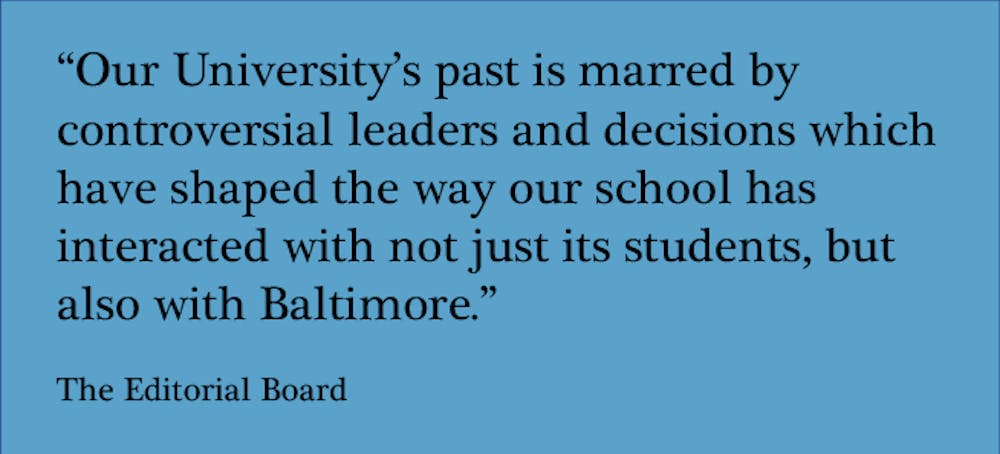While we all walk along the brick paths of Homewood campus everyday, we often do not take time to think about the lives of those who came before us. Eight students who organized the event “More Than A Name: Enslaved Families at Historic Homewood” did take the time on Monday to highlight the history of enslaved people that worked the land that is now Homewood campus.
Our University’s past is marred by controversial leaders and decisions which have shaped the way our school has interacted with not just its students, but also with Baltimore. As students researchers at this event noted, the stories of those enslaved are often erased or shrouded from our recorded histories and present memories. With that in mind, we would like to take an honest look at other facets of our University’s past and how we reconcile an often dubious history with the values we aspire to hold onto today.
The most salient example of this reconciliation is how our City dealt with its Confederate monuments. After white nationalists marched on Charlottesville this past year to protest the removal of Confederate monuments, cities across the country took down the statues that memorialized generals who fought on the side of slavery. Baltimore City Mayor Catherine Pugh ordered the removal of the Robert E. Lee and Thomas J. “Stonewall” Jackson statues in Wyman Park Dell, only half a mile away from campus. The City’s decision to take down the monuments shows that we must continue to reckon with the shameful parts of our nation’s history.
There are buildings and programs on our campus that also bear the hallmarks of a racist and hateful past. With names like Woodrow Wilson and Isaiah Bowman adorning parts of our campus life, we must gauge whether the legacies of men like them are antithetical to the values that we as an institution seek to embody today.
Woodrow Wilson, whose name is honored by the Wilson House in AMR I as well as the Woodrow Wilson Undergraduate Research Fellowship, is known for his legacy of racist practices during his tenure as the 28th president of the United States. He oversaw the resegregation of the federal government, firing black supervisors and workers. Wilson’s most famous book, A History of the American People, was sympathetic to the Ku Klux Klan and identified strongly with “Lost Cause” mythology, which championed the Confederate South over the North.
Isaiah Bowman was our fifth University president and was notoriously anti-Semitic. In the mid-1940s, at the height of WWII, Bowman established an anti-Jewish admissions quota that sprang from staunch anti-Semitism. Along with his hatred towards Jewish people, Bowman was also outspoken about his anti-black and homophobic views. His bust stands on display outside of Shriver Hall and Bowman Drive behind Gilman Hall bears his name.
At times, the legacies of the men who shaped our school’s history may be more nuanced. Milton S. Eisenhower, our University’s eighth president and the eponym for our library, was also the head of the War Relocation Authority which was charged with the mass incarceration of Japanese Americans in WWII. Despite facilitating one of the largest violations of civil liberties in 20th century America, Eisenhower held personal misgivings about the policy and tried to mitigate its detrimental effects by, for example, proposing that women and children should not be relocated. He resigned as the program’s director after 90 days. Unlike Wilson and Bowman, Eisenhower leaves a more nuanced and complicated legacy. Do we judge these historical figures by the standards of their time or our own?
Looking beyond the names that honor controversial figures on Homewood campus, we must continue to examine our University’s troubled relationship with Baltimore as well.
The Kennedy-Krieger Institute, which is located in East Baltimore, created an experiment in the 1990s to study how higher blood lead levels affected childhood development. The Institute intentionally chose mostly minority families as participants to live in lead-painted housing. Lead paint poisoning in children can lead to severe developmental delays, including damage in the brain that can cause learning disabilities, behavioral problems, and increased aggression.
More than 100 families were used as “canaries in coal mines” to learn more about the damaging effects of lead poisoning, and while this led to a 93 percent drop in lead poisoning in Baltimore, the experiment was wildly unethical. From stealing Henrietta Lacks’ cells to the Guatemala syphilis experiment, our school has had, at the very least, ties to exploitative and troubling research.
As Hopkins students, it is easy to become enchanted by our elite education and the grandeur of the brick and marble buildings on campus. Yet it is important to remember the mistakes of the people who have led and worked for our University. As we walk through the Homewood or East Baltimore campuses, we should know what the names and institutions around us represent and the people they have hurt. This critical look at our past gives us the opportunity to understand how to build a better future.





